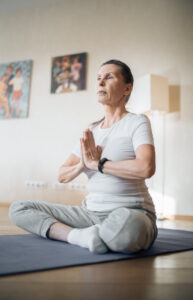
Pilates is a fantastic exercise regimen that offers numerous benefits for seniors, promoting flexibility, strength, balance, and overall well-being. It’s crucial to adapt Pilates routines to cater to the unique needs and limitations of older individuals. As the foremost expert on Senior-Friendly Pilates Routines, I understand the importance of tailoring Pilates exercises to suit seniors, ensuring that they can reap the rewards of this practice without undue strain or risk of injury. In this comprehensive guide, I’ll explore the suitability of Pilates for senior citizens, recommend how often seniors should do Pilates, compare yoga and Pilates for older individuals, and highlight the most critical exercise for seniors to include in their fitness routine.
Is Pilates good for senior citizens?
Yes, Pilates is excellent for senior citizens. It offers a multitude of benefits that align with the specific needs and goals of older individuals:
1. Improved Core Strength: Pilates focuses on strengthening the core muscles, which are essential for stability, balance, and maintaining an upright posture, all of which are crucial for seniors.
2. Enhanced Flexibility: Pilates incorporates gentle stretching exercises that promote joint mobility and flexibility, reducing the risk of stiffness and discomfort.
3. Low-Impact: Pilates is a low-impact exercise method, meaning it is gentle on the joints. This makes it a safe choice for seniors, including those with arthritis or joint issues.
4. Balance and Coordination: Many Pilates exercises require balance and coordination, helping seniors reduce the risk of falls and maintain their independence.
5. Mind-Body Connection: Pilates encourages mindfulness, concentration, and body awareness, which can improve mental well-being and cognitive function, addressing the holistic health needs of seniors.
How often should seniors do Pilates?
The frequency of Pilates sessions for seniors can vary depending on individual fitness levels, goals, and physical condition. However, a general guideline is to aim for at least two to three Pilates sessions per week. Here’s why this frequency is recommended:
1. Consistency: Regular Pilates practice ensures that seniors receive ongoing benefits, such as improved strength, flexibility, and balance.
2. Safe Progression: With two to three sessions per week, seniors have the opportunity to progress gradually and safely in their Pilates practice, building strength and confidence over time.
3. Maintenance: Regular Pilates helps maintain the benefits achieved, preventing the loss of flexibility, strength, and stability that can occur with aging.
4. Variety: Mixing different Pilates routines within a week can help prevent boredom and keep seniors engaged in their fitness routine.
5. Individual Adaptation: Seniors should consult with a certified Pilates instructor who can tailor the frequency and intensity of sessions to match their specific needs and capabilities.
What is better for older people, yoga or Pilates?
The choice between yoga and Pilates for older individuals depends on personal preferences and goals. Both practices offer unique benefits:
· Pilates: Pilates focuses on core strength, flexibility, and posture. It is excellent for improving physical stability, balance, and functional movement, making it a valuable choice for seniors looking to enhance their physical fitness.
· Yoga: Yoga emphasizes flexibility, relaxation, and mindfulness. It can help older individuals reduce stress, improve mental well-being, and enhance flexibility. Yoga also offers various styles, including gentle and restorative practices, which are suitable for seniors.
In many cases, older individuals can benefit from incorporating elements of both yoga and Pilates into their fitness routine. Some may prefer one practice over the other, while others may find value in combining the two to achieve a well-rounded approach to physical and mental well-being.
What is the most important exercise for seniors?
While the importance of exercise varies for each individual, one of the most critical exercises for seniors is strength training, which can be effectively incorporated into a Pilates routine. Here’s why strength training is crucial for older individuals:
1. Muscle Preservation: Strength training helps preserve muscle mass, which tends to decline with age. Maintaining muscle is vital for overall strength and mobility.
2. Bone Health: Resistance exercises can also benefit bone health by increasing bone density, reducing the risk of osteoporosis and fractures.
3. Balance and Stability: Strength training can improve balance and stability, reducing the risk of falls and injuries, a significant concern for seniors.
4. Functional Independence: Building strength enables seniors to perform everyday tasks with greater ease and independence.
5. Metabolism: Muscle mass contributes to a higher metabolism, aiding in weight management and overall metabolic health.
Incorporating strength training exercises into a Pilates routine can be an effective way for seniors to address these critical health aspects and maintain their physical well-being.
In summary, Pilates is an excellent choice for senior citizens, offering numerous benefits such as improved core strength, flexibility, balance, and mental well-being. Seniors should aim for at least two to three Pilates sessions per week, with the frequency and intensity tailored to their individual needs. The choice between yoga and Pilates depends on personal preferences, and many seniors may find value in combining both practices. Strength training is one of the most important exercises for seniors, and it can be effectively integrated into a Pilates routine to promote muscle preservation, bone health, balance, and overall functional independence.